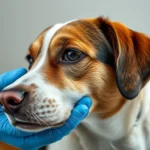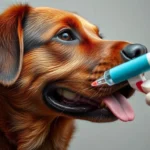
Lipomas are benign tumors composed of fatty tissue that can appear in various parts of a dog’s body. They are commonly seen in middle-aged to older dogs, often causing concern for pet owners. The importance of consulting a veterinarian cannot be overstated, as they are the best source for understanding and managing your pet’s health. This article aims to provide a lipoma in dogs vet answer by exploring the nature of lipomas, their symptoms, diagnosis, treatment options, and preventive measures.
What is a Lipoma?
Definition of Lipoma
A lipoma is a soft, fatty tumor that usually forms just beneath the skin. These lumps are generally round and can vary in size from a small marble to several inches in diameter. Lipomas are typically non-painful and slow-growing, making them easily manageable in many cases. However, they can be concerning to pet owners when they notice a new lump on their dog.
Types of Lipomas
Lipomas can be categorized into two primary types: soft and hard lipomas. Soft lipomas are the most common and have a squishy texture. In contrast, hard lipomas are denser and feel firmer to the touch. There are also other types of fatty tumors, such as fibrolipomas, which can exhibit different characteristics. Understanding the types of lipomas can help in identifying their nature and determining the need for treatment.
Causes and Risk Factors
Potential Causes of Lipomas
The exact cause of lipomas in dogs is not fully understood, but there are several potential factors that may contribute to their development. Genetic predisposition plays a significant role, as certain breeds are more susceptible to developing lipomas. Additionally, obesity can influence the formation of these fatty tumors, as excess body fat can lead to an increased likelihood of lipoma development.
Common Breeds Prone to Lipomas
Some dog breeds are more prone to developing lipomas than others. Notable breeds include:
- Labrador Retrievers
- Golden Retrievers
- Doberman Pinschers
- Boxers
- Cocker Spaniels
If you own one of these breeds, it’s essential to monitor their health closely and consult your veterinarian regularly.
Symptoms of Lipomas in Dogs
Visual Identification
Lipomas are typically easy to identify due to their distinct appearance. They often feel like soft, movable lumps under the skin. Characteristics include:
- Size: Can range from a pea-sized lump to several inches in diameter.
- Shape: Usually round or oval.
- Texture: Soft and squishy to the touch.
Associated Symptoms
While most lipomas are benign and do not cause discomfort, there are instances when they can be concerning. If you notice any of the following signs, it’s time to consult your vet:
- Rapid growth of the lump.
- Discomfort or pain when touched.
- Changes in behavior, such as lethargy or reluctance to play.
Differentiating Lipomas from Other Conditions
It’s crucial to recognize when a lump warrants further examination. Other conditions, such as sebaceous cysts or malignant tumors, can mimic the appearance of lipomas. If you are unsure about a lump on your dog, seeking veterinary advice is always the best course of action.
Diagnosis of Lipomas
Veterinary Examination
When you bring your dog to the vet for a lump evaluation, the veterinarian will conduct a thorough physical examination. They will palpate the lump to assess its size, texture, and mobility. This initial assessment is critical in determining whether further tests are necessary.
Diagnostic Tests
To confirm the presence of a lipoma and rule out other conditions, your vet may perform several diagnostic tests, including:
- Fine Needle Aspiration (FNA): A procedure where a thin needle is inserted into the lump to extract cells for examination.
- Ultrasound: An imaging test that can provide a clearer picture of the lump’s structure and surrounding tissues.
Importance of Accurate Diagnosis
Accurate diagnosis is essential for distinguishing lipomas from malignant tumors. Misdiagnosing a cancerous tumor as a benign lipoma can lead to severe consequences. Therefore, if you notice any unusual growths on your dog, it’s vital to consult your veterinarian for a proper diagnosis.
Treatment Options for Lipomas
Monitoring Lipomas
In many cases, treatment for lipomas may not be necessary. If the lipoma is small, soft, and not causing discomfort, your veterinarian may recommend simply monitoring it over time. Regular check-ups can help ensure that it does not change or grow.
Surgical Removal
If a lipoma is causing discomfort, growing rapidly, or located in a problematic area, surgical removal may be indicated. The procedure involves excising the lipoma under general anesthesia. Most dogs recover well from this surgery, but it’s essential to follow your vet’s aftercare instructions.
Alternative Treatments
Some pet owners look for non-surgical interventions to manage lipomas. While there is limited scientific evidence supporting these methods, some options include:
- Dietary changes: Switching to a low-fat diet may help manage your dog’s weight and overall health.
- Supplements: Omega-3 fatty acids and other natural supplements may contribute to skin and coat health, although their efficacy for lipoma treatment is not well-established.
Aftercare and Recovery
Post-surgery care is crucial for a smooth recovery. Pet owners should monitor the surgical site for signs of infection, such as redness, swelling, or discharge. It’s also essential to follow your vet’s recommendations regarding activity restrictions and feeding.
Preventive Measures
Healthy Diet and Exercise
Maintaining a healthy weight through proper nutrition and regular exercise is one of the most effective ways to prevent lipomas. A balanced diet rich in nutrients, combined with consistent physical activity, can help reduce the risk of obesity and, consequently, lipoma development.
Regular Veterinary Check-ups
Routine veterinary check-ups are vital for early detection of any health issues, including lipomas. Regular examinations allow your vet to monitor your dog’s overall health and catch potential problems before they become serious.
Frequently Asked Questions (FAQs)
Are lipomas painful for dogs?
Lipomas are generally not painful, as they are benign and grow slowly. However, if a lipoma becomes large or is located in a sensitive area, it may cause discomfort. Always consult your vet if you notice any changes in your dog’s behavior or health.
Can lipomas turn into cancer?
Lipomas are benign tumors and do not turn into cancer. However, other types of lumps or growths can be malignant, so it’s essential to have any new or unusual lumps evaluated by a veterinarian.
What should I do if I find a lump on my dog?
If you find a lump on your dog, it’s crucial to consult your veterinarian as soon as possible. They can perform a thorough examination and, if necessary, run diagnostic tests to determine the nature of the lump.
How can I tell if a lipoma is growing?
Monitoring the size and shape of the lump over time is the best way to determine if a lipoma is growing. If you notice any rapid changes, such as an increase in size or discomfort for your dog, consult your veterinarian promptly.
Conclusion
Understanding lipomas in dogs is essential for pet owners. They are generally benign, but monitoring their development and seeking veterinary advice is crucial. If you notice any lumps or changes in your dog’s health, don’t hesitate to reach out to your vet for guidance. Keeping a close eye on your dog’s health will ensure that they live a happy and healthy life.









